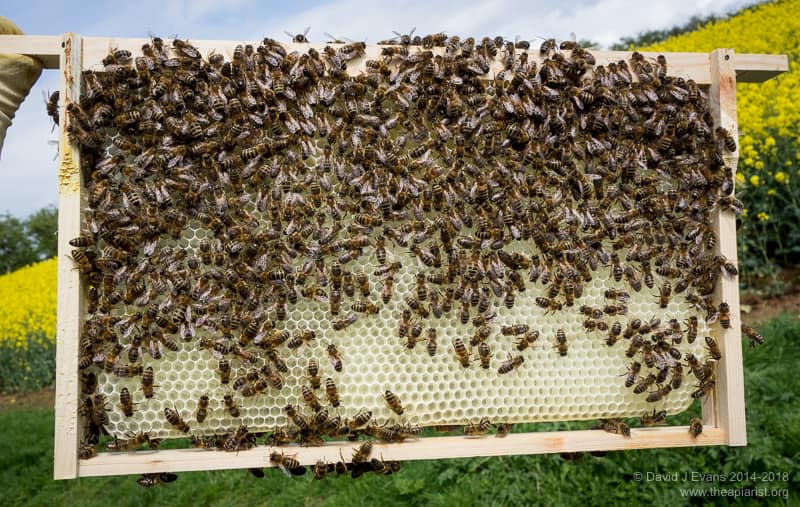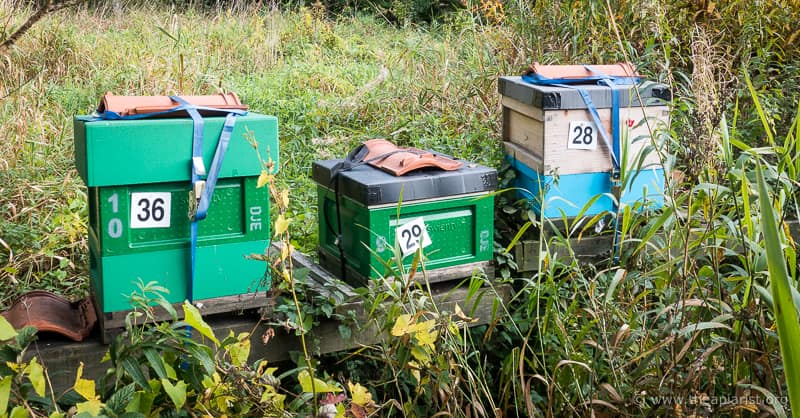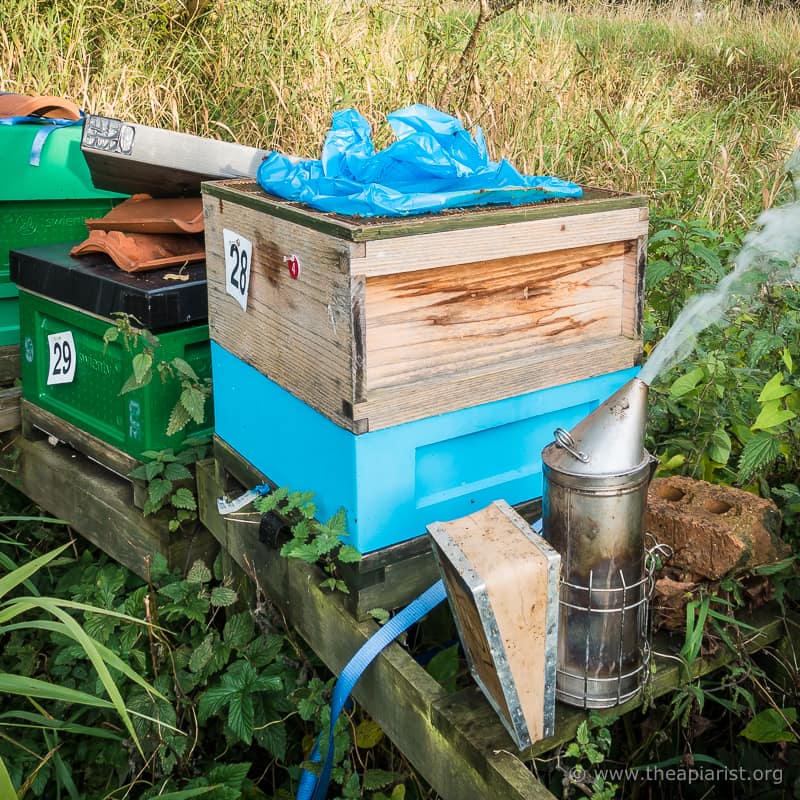Queens and amitraz residues in wax
A question following a recent evening talk to a beekeeping association prompted me to look back at the literature on amitraz and wax residues.
The question was about reuse of honey supers that were present on a colony during miticide treatment.
With the exception of MAQS, there are no approved miticides that should be used if there are honey supers on the hives. The primary reason for this is that there is a risk that the miticide will taint the honey. Since the latter is for human consumption this is very undesirable.
However, it’s not unusual at the end of the season to have a half empty super, or a super containing just uncapped stores. Typically this would be ‘nadired’ i.e. placed below the brood box, with the expectation that the bees will move the stores up into the brood chamber {{1}}.
And sometimes this super remains in place during the annual early autumn Varroa slaughter.
The question was something like “Can I reuse the honey super next season?”
My answer
As anyone who has heard me speak will know, my answer was probably rambling, repetitive and slightly incoherent 🙁
However, the gist of it was “Yes, but I don’t”.
With Zoom talks and written questions from the audience you often don’t get all the details. The answer must be sufficiently generic to cover most eventualities {{2}} including, for example, the range of possible miticides that were used for treatment.
Assuming the nadired super is emptied by the bees during the winter, what are the chances that the wax comb will be contaminated with miticides?
This depends upon the miticide used.
I explained that the organic acids (formic or oxalic) are not wax soluble and so the super can be reused without a problem.
In contrast, Apistan (a pyrethroid) is known to be wax soluble, so it should probably not be used again to avoid any risk of tainting honey subsequently extracted from it {{3}}.
But (I probably digressed) you really shouldn’t be using Apistan as resistance in the mite population is already widespread.
But what about Apivar (the active ingredient of which is amitraz)?
Since Apivar isn’t wax soluble it would probably be OK to reuse the super … but I qualified this by saying that I don’t reuse them “just to be on the safe side”.
What they don’t tell you about Apivar
This wasn’t really an application of the precautionary principle.
Instead, it reflected a dim memory of some posts I’d read earlier in the year on the Bee-L discussion forum. This is a low volume/high quality forum frequented by scientifically-inclined beekeepers.
It turns out that, although amitraz (the active ingredient in Apivar) is not wax soluble, it’s broken down (hydrolysed) to a formamide and a formamidine.
Read that again … I didn’t write the same word twice 😉
The formamide has no residual activity against mites. In contrast, the formamidine retains miticidal activity and is wax soluble.
Is this a problem?
Well, possibly. One of the things discussed by Richard Cryberg on Bee-L was that there appears to be no toxicology data on these two products. It’s probably been done, just not published.
Perhaps we can assume that they’re not hideously toxic to humans (or bees)? If it was, amitraz (which is the active ingredient in all sorts of mite and tick treatments, not solely for bees) would carry sterner warnings.
Or should 🙁
The residual miticide activity is potentially more of a problem. A well understood route to developing miticide resistance involves long-term exposure to sub-lethal doses. There are several reports of amitraz resistance in the scientific literature, and bee farmers are increasingly providing anecdotal accounts of resistance becoming a problem.
This, and the possibility of tainting honey, are reason enough in my opinion to not reuse drawn supers that have been on the hive (e.g. nadired) during Apivar treatment.
But it turns out that there are additional potential issues with amitraz residues in comb.
Miticide residues in wax
Commercial wax foundation – like the stuff you buy from Thorne’s or Maisemores or Kemble Bee Supplies – is often contaminated with miticide residues. A large US survey of drawn comb from hives and foundation demonstrated that:
Almost all comb and foundation wax samples (98%) were contaminated with … fluvalinate {{4}} and coumaphos {{5}}, and lower amounts of amitraz degradates and chlorothalonil {{6}}, with an average of 6 pesticide detections per sample and a high of 39.
I’m not aware of an equivalent published analysis of UK foundation. I’m know one has been done and I’d be astounded if it produced dramatically different results. There’s a global trade in beeswax, some of which will be turned into foundation. The only exception might be certified organic foundations.

A freshly drawn foundationless frame
I always purchase premium quality foundation but am under no misapprehension that it doesn’t also contain a cocktail of contaminants, including miticides and their ‘degredates’.
I’d be delighted to be proved wrong but, since I think that’s unlikely, it’s one reason I use an increasing number of foundationless frames … which also saves quite a bit of cash 🙂
Drones and queens and miticides in wax
Numerous studies have looked at the influence of miticide residues on worker, drone and queen development. These include:
- Sublethal doses of miticides can delay larval development and adult emergence, and reduce longevity {{7}}
- Tau-fluvalinate- or coumaphos-exposed queens are smaller and have shorter lifespans {{8}}
- Queens reared in wax-coated cups contaminated with tau-fluvalinate, coumaphos or amitraz attracted smaller worker retinues and had lower egg-laying rates {{9}}.
- Drones exposed to tau-fluvalinate, coumaphos or amitraz during development had reduced sperm viability {{10}}.
All of which is a bit depressing 🙁
These studies used what are termed ‘field-realistic’ concentrations of the contaminating miticide. They didn’t use wax saturated in miticide, but instead contaminated it with parts per million (ppm), or parts per billion (ppb).
These are the highest concentrations reported in surveys of comb tested in commercial beekeeping operations in the US, so hopefully represent a ‘worst case scenario’.
It’s also worth noting that some commercial beekeepers in the US use significantly more – both in amount and frequency – miticides than are used by amateurs. If you read American Bee Journal or the Beesource forums it’s not unusual to find accounts of spring, mid-season, late-summer and mid-winter treatments, often of the same colonies.
Queen mating
To add to the literature above, a new paper was published in November 2020 which suggested that amitraz residues in wax increased the mating frequency of queens.
The paper is by Walsh et al., (2020) Elevated Mating Frequency in Honey Bee (Hymenoptera: Apidae) Queens Exposed to the Miticide Amitraz During Development. Annals of the Entomological Society of America doi: 10.1093/aesa/saaa041
This piqued my interest. Queen mating frequency is an important determinant of colony fitness.
If a queen mates with more drones there’s inevitably increased genetic diversity in the colony and, in landmark studies by Thomas Seeley, an increase in colony fitness {{11}}.
Colony fitness includes all sorts of important characteristics – disease resistance, foraging ability, overwintering success etc.
So, perhaps this is a benefit of amitraz residues in your wax foundation … the reduced egg-laying rate being compensated by increased patrilines {{12}} and a fitter colony?
The study
Walsh and colleagues grafted queens into JzBz queen cups containing wax laced with one or more miticides. They reared the queens in ‘cell builders’ that had not been miticide treated, shifted mature queen cells to mating nucs and then – after successful mating – quantified two things:
- the viability of spermatozoa in the queen’s spermatheca
- the mating frequency of the queen
Irrespective of the miticides incorporated into the wax lining the queen cup, sperm viability was very high (98.8 – 99.5% viable), and no different from queens not exposed to miticides during development.

Queen cells after emergence in mating nucs
This suggests that miticide contamination of queen cells is unlikely to have a deleterious effect on sperm viability in mated queens.
However, rather oddly, this contradicts a not dissimilar study 5 years ago from some of the same authors where the presence of tau-fluvalinate and coumaphos did reduce sperm viability {{13}}, as did an earlier study looking at the effect of amitraz {{14}}.
This contradiction is pretty-much ignored in the paper … clearly something that “needs further investigation”.
It might be due to experimental differences (for example, they used different methods to determine sperm viability). Alternatively, since the queens were open-mated, it might reflect differences in the miticide-exposure of the donor drones.
Mating frequency
The authors used microsatellite analysis to determine the mating frequency of the queens reared during the study. They compared queens reared in the presence of amitraz or tasty cocktails of tau-fluvalinate & coumaphos, or clorothalonil & chlorpyrifos {{15}}, with those reared in the absence of chemicals contaminating the waxed queen cup.
They measured the observed mating frequency and then calculated the effective mating frequency (me). Conveniently they describe the difference between these parameters:
The observed mating frequency refers to the total number of drone fathers represented in a queen’s worker progeny. The effective mating frequency uses the proportion of each subfamily within a colony and compensates for calculating potentially skewed estimates of paternity (i.e., unequal subfamily proportions in sampled pupae) and intracolony genetic relatedness.
‘Convenient’ because it saves me having to explain it 😉
The observed mating frequencies of the control queens (untreated wax), or those reared in the presence of amitraz or tau-fluvalinate & coumaphos cocktails were not statistically different. However, queens reared in clorothalonil & chlorpyrifos-laced wax had a lower observed mating frequency.
Strikingly though, when calculated, the effective mating frequency of amitraz- or tau-fluvalinate & coumaphos-exposed developing queens was significantly higher (~12.9-13.4) than either the untreated controls or clorothalonil & chlorpyrifos (~8.2-8.8) {{16}}.
And … ?
The amitraz result is new.
The influence of tau-fluvalinate & coumaphos on effective mating frequencies has been reported previously (by some of the same authors {{17}}) which, since this was a new study in a different region, is at least encouraging because it supports the earlier work.
Taken together, these results suggest that miticide residues (of at least two chemically different types) increase the number of drones that a queen mates with.
The discussion of the paper speculates about why this difference is observed.
The number of drones a queen mates with is influenced by several things. These include the number and duration of the mating flights. Perhaps the amitraz-exposed queen can’t count properly, or loses her ability to judge time … or just flies more slowly?
All of these would result in exposure to more drones.
Before returning to the hive, a queen must be able to determine whether she has mated with sufficient drones. It is suggested that stretch receptors in the oviducts are involved with this, forming a negative feedback stimulus once the oviducts are full. Perhaps amitraz impairs stretch receptor function or signalling?
Clearly there’s a lot left to learn.
Hyperpolyandry
The effective mating frequencies determined in the presence of amitraz (and tau-fluvalinate & coumaphos) were higher than the controls. However, they still appear rather low when compared with previous reports of hyperpolyandrous {{18}} colonies with up to 77 distinct patrilines (I’ve written about this previously, including descriptions of how it was determined).
Don’t mix the two observations up. In the studies of hyperpolyandry they analysed queens to determine their patriline.
A queen from a very rare patriline is still a queen, so can be screened.
In contrast, if you only screen a handful of workers (from the thousands present in the colony), you are very unlikely to find extremely rare patrilines. Those you do find will be the ones that are most common.
A logical extension of the studies reported by Walsh et al., would be to determine whether hyperpolyandry also increased in amitraz-exposed colonies. If the effective mating number is increased you should observe a larger number of patrilines.
Alternatively, perhaps Withrow and Tarpy (who published the hyperpolyandry paper {{19}}) should look again at whether the colonies they screened had a long history of amitraz exposure.
And what about that nadired super?
It’s probably fortunate I’d not fully read the literature before answering the question after my talk.
If I had, I’d have tried to paraphrase the ~2000 words I’ve just written … so making my answer interminably long.
Of course, it’s unlikely that an amitraz (Apivar) contaminated super will ever be visited by a queen (but these things do happen 🙁 ).
Or be a location for developing queen cells.
So, in this regard, I think it’s irrelevant whether the super is reused.
In contrast, the wax solubility and residual miticide activity of one of the hydrolysis products of amitraz is more of a concern. I don’t want this near honey I’m going to extract, and I’d rather not have it in the hive at all.
All of which explains the “Yes, but I don’t” answer to the original question about whether the super can be reused.
The super in the picture above will be removed early next season, before the queen starts laying in it. The super will be empty and I’ll melt the wax out in my steam wax extractor.
In a good nectar flow the bees will draw a full super of comb very quickly. Yes, they’ll use some nectar that would otherwise be used make honey, but that’s a small penalty.
And what will I do with the extracted wax?
I’ll probably trade it in for new foundation {{20}}.
And since this is what many beekeepers do it explains why I’m certain that most commercial foundation is contaminated with miticides 🙁
But don’t forget …
Mite management is important. Miticides are chemicals and, like other medicines, have both beneficial and detrimental effects. The beneficial effects far outweigh the detrimental ones. If you do not treat, the likelihood is that mites and viruses will kill the colony … if not immediately, then eventually.
{{1}}: I discussed the rationale behind nadiring a few weeks ago.
{{2}}: The alternative is to engage in a to and fro “turn your microphone on … bottom left of the screen … no, I still can’t hear you … ah, that’s better … “, which gets frustrating for the audience. Far better to save that for a breakout session after the Q&A at which anyone still interested can have a general chat.
{{3}}: Supers of drawn comb are valuable and are used over and over again. The majority of mine are 5-10 years old.
{{4}}: e.g. Apistan.
{{5}}: A phosphorothioates.
{{6}}: A fungicide.
{{7}}: Wu et al., 2011. Sub-lethal effects of pesticide residues in brood comb on worker honey bee (Apis mellifera) development and longevity. PLoS One 6: e14720.
{{8}}: Haarmann et al., 2002. Effects of fluvalinate and coumaphos on queen honey bees (Hymenoptera: Apidae) in two commercial queen rearing operations. J. Econ. Entomol. 95: 28–35.
{{9}}: Walsh et alI., 2020. Queen honey bee (Apis mellifera) pheromone and reproductive behavior are affected by pesticide exposure during development. Behav. Ecol. Sociobiol. 74: 33.
{{10}}: Fisher & Rangel. 2018. Exposure to pesticides during development negatively affects honey bee (Apis mellifera) drone sperm viability. PLoS One 13: e0208630.
{{11}}: Mattila & Seeley (2007) Genetic Diversity in Honey Bee Colonies Enhances Productivity and Fitness. Science 317:362-364.
{{12}}: Patriline indicates a distinct relationship inherited through the male line.
{{13}}: Rangel, J., and D. R. Tarpy. 2015. The combined effects of miticides on the mating health of honey bee (Apis mellifera L.) queens. J Apic. Res. 54: 275–283.
{{14}}: Burley, L. M. 2007. The effects of miticides on the reproductive physiology of honey bee (Apis mellifera L.) queens and drones. Master’s thesis, Virginia Polytechnic Institute, Blacksburg, VA.
{{15}}: An organophosphate pesticide
{{16}}: Though it’s worth noting that these look a bit low …
{{17}}: Rangel, J., and D. R. Tarpy. 2015. The combined effects of miticides on the mating health of honey bee (Apis mellifera L.) queens. J Apic. Res. 54: 275–283.
{{18}}: Polyandry means multiple mating (one female, multiple males), and hyperpolyandry means even more.
{{19}}: Withrow JM, Tarpy DR (2018) Cryptic “royal” subfamilies in honey bee (Apis mellifera) colonies. PLoS ONE 13: 0199124. https://doi.org/10.1371/journal.pone.0199124.
{{20}}: Or produce some more firelighters.


Join the discussion ...